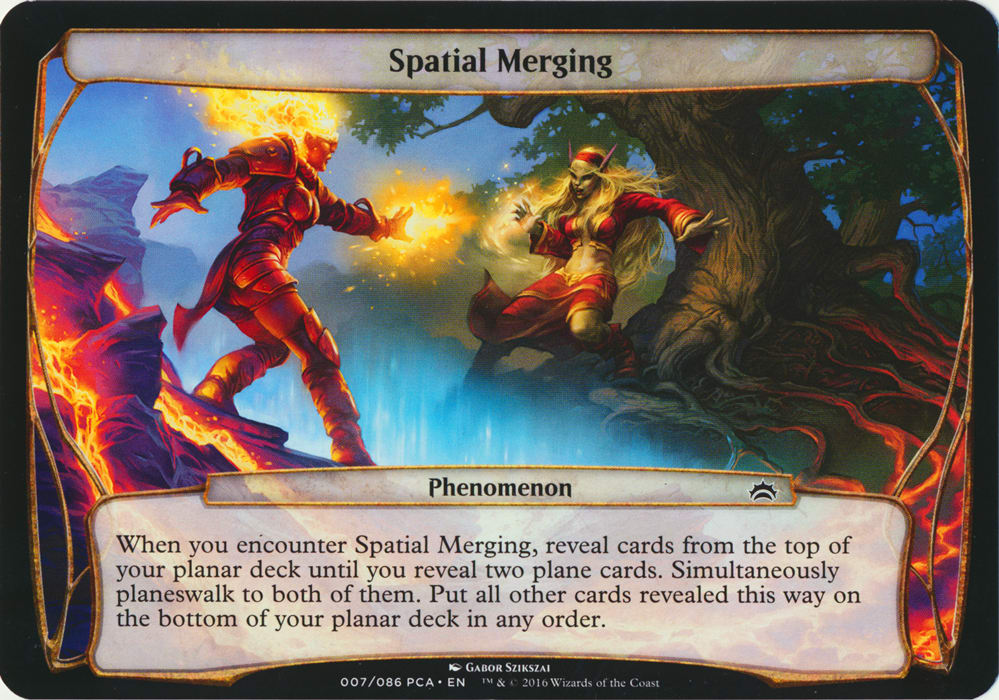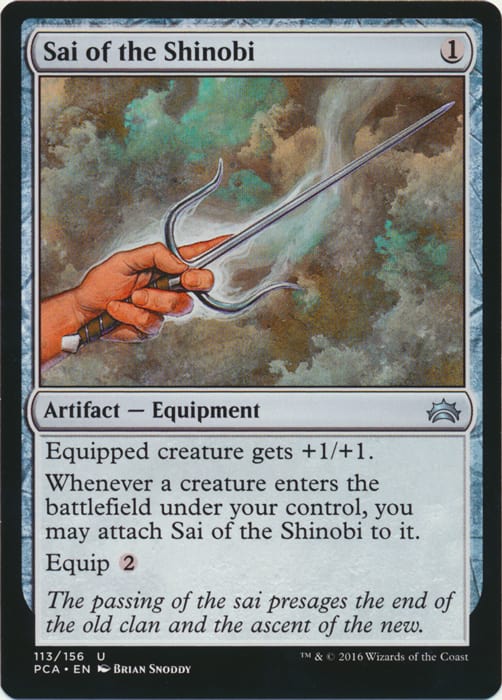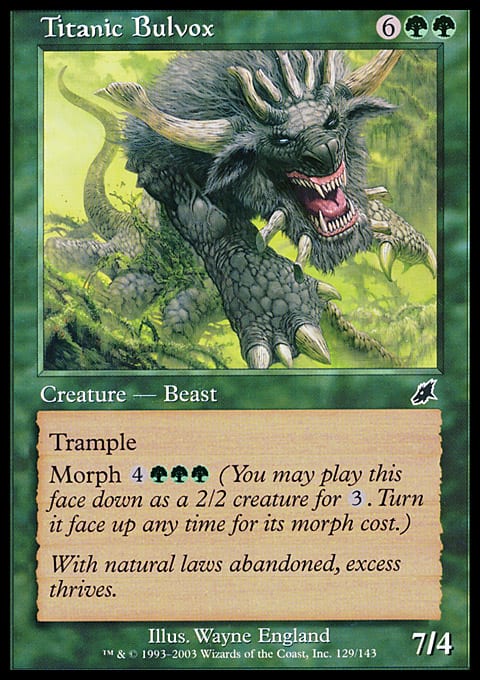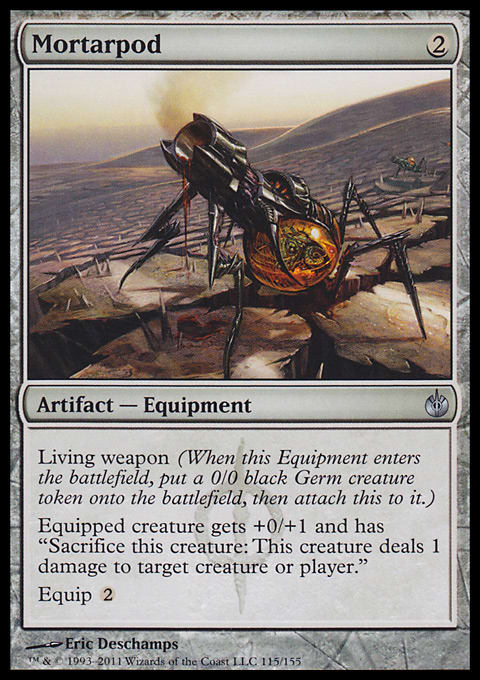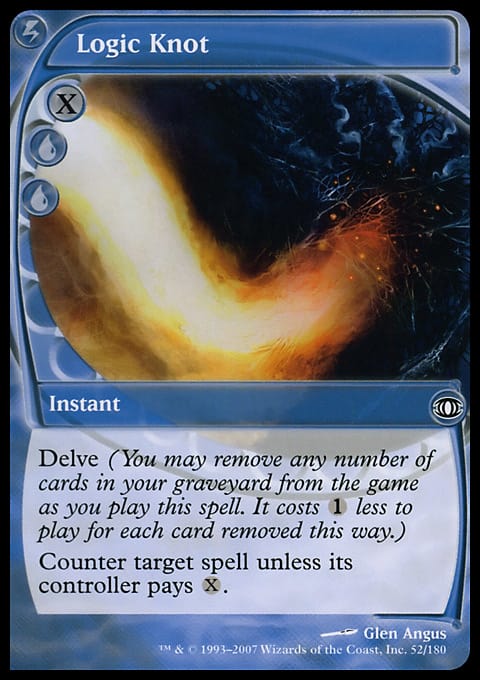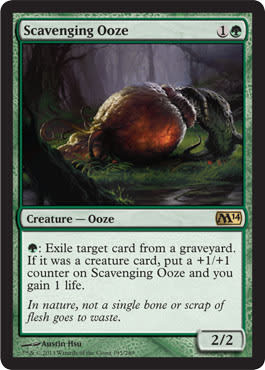Unfortunately, I still haven’t managed to get another Cube Draft together for testing the most recent implementation of player abilities, but that doesn’t mean there’s nothing to talk about. On the contrary, Wizards of the Coast provided a topic for discussion by releasing Planechase 2012 last Friday.
Back in 2009, my brother and I bought a couple of the original Planechase decks, but we never played with the sealed product. The planes were quickly co-opted for games of Type 4 and what was then EDH, and we had fun playing with them, but we eventually left them by the wayside because they were too difficult to transport. Flash forward three years. Now the Magic community has access to sleeves and deck boxes made for oversized cards, and the folks in R&D have a much better idea of how to craft a Planechase format. I figured it was time to give things another go.
Pre-Constructing an Experience
On the eve of the new product’s release, I was fortunate enough to be sitting in my local game store, waiting around before FNM. It wasn’t long before local ringer and good friend Claude Schmit swooped in to buy a set of the decks, and soon, we had a four-player free-for-all going with the planes all shuffled together.
For this round, I ended up with Chaos Reigns, and happily so. As both a player and a designer, I love cascade. It makes for exciting gameplay and adds variance without turning off the majority of players like coin flipping does. Really, I could go on for this whole article about how cascade introduces randomness the right way, but seeing as Mark Rosewater already did that, I’ll just direct you to his column instead.
As for the actual gameplay, pretty early on, I noticed something interesting: Chaos Reigns seemed to be the only deck really playing to take control of the game. Primordial Hunger and Savage Auras both are looking to stick one enormous creature and ride it to victory in this removal-light environment (a role that the former is much better prepared to assume).
And though Night of the Ninja looks like it has tools for a long game, they all require hitting an opponent, so it really acts as more of a scavenger, picking apart whoever isn’t doing anything . . . or at least that’s what it would do if the cards ever combined in an adequately powerful fashion. It’s entirely possible that Savage Auras and Night of the Ninja simply synergize better with their planes than the other decks do with theirs and we missed out on that experience by shuffling everything together, but it certainly made it demoralizing to be stuck with the Aura deck for the second round of chasing planes.
Nevertheless, the games were fun, and I was happy to see that all of the decks were a little bit light on action in order to encourage the players to roll the planar die more often. Planeswalking is fun. I mean, it’s almost like cascade or something!
Applications in Other Worlds
While I’m sure the good folks at WotC spent a lot of effort to make the preconstructed decks fun, that’s not really the product’s main goal. Planechase makes Magic even more complex, and as such, it’s not really aimed at new players. The target audience here already owns multiple decks, and after playing a few games with the arrangements each box contains, they’re likely to strip out exciting cards for other uses. That means the normal-sized cards need to stand on their own as fun cards for casual decks, and the planes and phenomena need to make good games not just when combined together, but also when combined with their forbearers.
Singles in Your Area
In general, I’d say the normal cards do their job admirably, with the only notable miss being the underwhelming Sai of the Shinobi.
The gameplay here is fun, but the bonus is so underwhelming as to invalidate the work put in by the player. I mean, compare this card to Vigean Hydropon or Primal Forcemage for a second. If I’d been on the development team for this product, I’d have pushed this card to a higher cost and added a saboteur effect in place of the bonus. Maybe something like this:

Even the simple, “That player discards a card,” would make this Equipment much more exciting to sneak onto your Ninja, and aside from wanting room for flavor text, I can’t figure out why the official version was chosen.
The only other questionable inclusion in my book is Fractured Powerstone.
I don’t so much have a problem with the card only working in one format as I’m concerned that it will never be played. If you have a single playgroup that you always hang out with, you might have a dedicated deck for Planechase and an accompanying planar deck, but the rest of us are going to play this format almost exclusively with a shared deck because we can’t reasonably expect players to bring their own planes. That means people will be playing decks designed for other formats, and this card won’t be in any of them. If R&D decided that this card had to be printed, I fully support the choice to make it a reasonable card on its own, but I imagine that choice still won’t be enough to earn it a spot in most players’ arsenals.
On a lighter note, I’m going to go ahead and call Mass Mutiny the greatest success of the bunch. Sure, Thormok the Insatiable might well prove to be more fun, but Mass Mutiny managed to capture most of the good things about Insurrection without copying the vomit-inducing quality of ignoring all of your opponents’ efforts in the first seventeen turns of the game.
Supersize Me
As for the planes, of the thirty-two new ones, twenty-one of them have what I’d classify as group-hug effects. They generate mana, draw cards, gain life, or otherwise benefit any player who gets to take his turn in that realm. Seven of them are a bit griefier, forcing discard, sacrifice, and general misery upon the table. I’m not sure what the right numbers are, but from the small sample size I’ve experienced thus far, I’d wager that even 22% is too many griefer planes for most groups. That said, this overabundance is still preferable to increasing the number of The Zephyr Mazes.
It’s not just that the card seems to unfairly benefit one player. Even rolling the chaos ability multiple times isn’t going to bring you close to the same reward that said other player receives naturally. This contrast would be fine if most people were going to be playing with individual planar decks, but as I don’t think that’s going to be the case, this sort of plane will just make an already swingy format swingier without adding any new dimensions to it. I hope I’m wrong, a ton of people play the format as intended, and The Zephyr Maze is a big hit, but either way, I certainly hope we’ll see a poll on the mothership gathering that data sooner rather than later.
Ticking Forward
With all of that analysis out of the way, I’d like to take a minute to look at the implications this most recent summer multiplayer product has for those yet to come. Last year when Magic: The Gathering Commander released, we saw new cards outside of an expansion for the first time in more than a decade, but with the decks’ success, the notion has quickly become a staple of the multiplayer product line.
Not content to play second fiddle to Commander’s accomplishments, Planechase 2012 doesn’t just have new cards; it has new cards from places we’ve been before. Nostalgia is a powerful force, and after hearing MaRo repeat how poorly received Kamigawa block was on his Tumblr page, one can only take the plane’s prominence in Night of the Ninja to be an indicator that summer products have less stringent requirements than blocks in this area. What other mechanics have been popular but can’t be revisited either because the blocks they reside in went over poorly or they’d cause problems in Standard? I certainly expect to see both morph and living weapon reappear at some point, and who knows: Maybe this practice will finally provide a home to delve.
Outside of their kitchen-table impact, these cards are also potentially useable in Legacy, and we saw an error in judgment there with the Commander decks.
Since the end of their print run, the decks’ prices have shaken out according to how much people want the cards inside, and Counterpunch is now a full $10 more than its closest competitor because it contains a card that sees serious Legacy play. (I’ll also note that Political Puppets is quite the steal on CoolStuffInc right now, so if you were thinking about picking that one up . . . )
Anyway, the point is that I’m happy not to see the same thing repeated here. Both Shardless Agent and Illusory Angel are two-ofs in their respected decks (not that I think the latter will be good), so in the event that they break out, and assuming that people spend the same amount of money on Planechase as they did on Commander, there will be almost four of each of these new creatures in circulation for every Scavenging Ooze.
But perhaps the product’s most subtle implication lies in the fact that it exists at all. Are the groups that Wizards aimed at with Planechase, Archenemy, and Commander the only sizeable portions of the multiplayer fan base? Is there no more to group play than chaos, teamwork, and epic haymakers? What about hanging out? I mean, it’s not as though I have any great ideas for a focused schmoozing-with-friends product, but having failed to make anything materialize for three years, Wizards will now face some backlash if they disrupt the Planechase → Archenemy → Commander cycle at some point in the future. Then again, we survived the Magic 2010 rules change and double-faced cards, so maybe, just maybe, they know what they’re doing.













